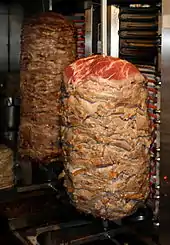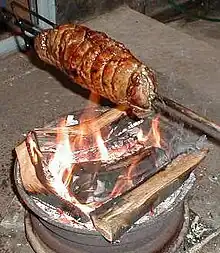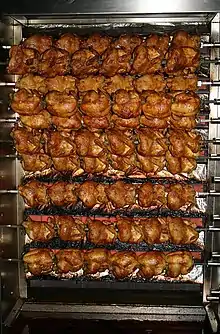This is a list of notable spit-roasted foods, consisting of dishes and foods that are roasted on a rotisserie, or spit. Rotisserie is a style of roasting where meat is skewered on a spit, a long solid rod used to hold food while it is being cooked over a fire in a fireplace or over a campfire, or roasted in an oven. Spit-roasting typically involves the use of indirect heat, which usually cooks foods at a lower temperature compared to other roasting methods that use direct heat.[1] When cooking meats, the nature of the food constantly revolving on a spit also creates a self-basting process.[1] Spit roasting dates back to ancient times, and spit-roasted fowl and game "was common in ancient societies".[2][3]
Spit-roasted foods

Doner kebab on a vertical spit

A kürtőskalács spit cake cooking on a spit roast
- Al pastor – a dish developed in central Mexico that is based on shawarma spit-grilled meat brought by Lebanese immigrants to Mexico.[4]
- Cabrito al pastor – a northern Mexican dish consisting of a whole goat kid carcass that is opened flat and cooked on a spit
- Cağ kebabı – a horizontally stacked marinated rotating lamb kebab variety, originating in Turkey's Erzurum Province
- Doner kebab – seasoned meat stacked in the shape of an inverted cone is turned slowly on a rotisserie, next to a vertical cooking element. The outer layer is sliced into thin shavings as it cooks.
- Gyros – a Greek dish made from meat cooked on a vertical rotisserie
- Inihaw – a general Filipino term for grilled or spit-roasted meat or seafood
- Lechon – a general Spanish term for whole spit-roasted pig common in Spain, Latin America, and the Philippines
- Lechon manok – a Filipino spit-roasted chicken dish made with chicken marinated in a mixture of garlic, bay leaf, onion, black pepper, soy sauce, and patis (fish sauce).
- Méchoui – a dish in North African cuisine consisting of a whole sheep or a lamb spit-roasted on a barbecue.
- Mutzbraten – an eastern Thuringia and western Saxony dish of meat from the shoulder or pig`s back, seasoned with salt, pepper and marjoram, marinated and cooked in birch wood smoke on so-called Mutzbraten stands.
- Obersteiner Spießbraten – a culinary specialty of Idar-Oberstein, Germany consisting of a rolled roast using beef or pork neck.
- Paksiw na lechon – a Filipino dish consisting of leftover spit-roasted pork (lechon) meat cooked in lechon sauce or its component ingredients of vinegar, garlic, onions, black pepper and ground liver or liver spread and some water.[5][6]
- Rotisserie chicken – a chicken dish cooked on a rotisserie, whereby the chicken is placed next to the heat source to cook it[7]
- Pollo a la Brasa – a common dish of Peruvian cuisine and one of the most consumed in Peru, it is a rotisserie chicken dish that is a Peruvian version of pollo al spiedo.[8][9]
- Shawarma – a Middle Eastern meat preparation based on the doner kebab of Ottoman Turkey
- Siu mei – the generic name in Cantonese cuisine given to meats roasted on spits over an open fire or a huge wood burning rotisserie oven.
- Spettekaka – a local dessert in some southern areas of Sweden, the name means "cake on a spit", which describes its method of preparation.[10]
- Spit cake – a European cake made with layers of dough or batter deposited, one at a time, onto a tapered cylindrical rotating spit
- Baumkuchen – a German variety of spit cake
- Kürtőskalács – a spit cake specific to Hungarian-speaking regions in Romania, more predominantly the Székely Land, and popular in Hungary and Romania[11][12]
- Baumstriezel – a similar pastry to Kürtőskalács originating from the Saxon communities of Transylvania
- Trdelník – a spit cake similar to Kürtőskalács popular in Slovakia and Czechia
- Šakotis – a Polish-Lithuanian traditional spit cake
- Suckling pig – traditionally cooked whole, often roasted, in various cuisines, and sometimes cooked on a rotisserie
Gallery
 Baumkuchen being prepared on a rotisserie
Baumkuchen being prepared on a rotisserie


 Shawarma in Lebanon, 1950
Shawarma in Lebanon, 1950 Siu mei – roasted goose (top left), chicken (top right) and pork (bottom)
Siu mei – roasted goose (top left), chicken (top right) and pork (bottom) Spanferkel, a spit-roasted suckling pig in German cuisine[13]
Spanferkel, a spit-roasted suckling pig in German cuisine[13]
 Several national variants of spit cakes
Several national variants of spit cakes
See also
- List of barbecue dishes
- List of cooking techniques
- List of kebabs
- List of meat dishes
- List of smoked foods
- Pig roast
- Category:Skewered foods
References
- 1 2 Famularo, J. (1992). The Joy of Grilling. Joy of Cooking Series. Barron's Educational Series, Incorporated. p. 219. ISBN 978-0-8120-4703-5. Retrieved January 25, 2019.
- ↑ Katz, S.H.; Weaver, W.W. (2003). Encyclopedia of Food and Culture: Obesity to Zoroastrianism. Index. Scribner library of daily life. Scribner. p. 206. ISBN 978-0-684-80565-8. Retrieved January 25, 2019.
- ↑ Walker, H. (1997). Food on the Move: Proceedings of the Oxford Symposium on Food and Cookery, 1996. Oxford Symposium on food & cookery. Prospect Books. p. 247. ISBN 978-0-907325-79-6. Retrieved January 25, 2019.
- ↑ "The Lebanese connection". Los Dos Cooking School. Archived from the original on April 26, 2016. Retrieved January 24, 2019.
- ↑ Posadas, J. (2011). Etiquette Guide to the Philippines: Know the Rules that Make the Difference!. Tuttle Publishing. p. pt44. ISBN 978-1-4629-0046-6. Retrieved January 24, 2019.
- ↑ Roces, A.R. (1978). Filipino Heritage: The Spanish colonial period (17th. Filipino Heritage: The Making of a Nation. Manila: Lahing Pilipino Pub. p. 1153. Retrieved January 24, 2019.
- ↑ Raichlen, S. (2011). How to Grill: The Complete Illustrated Book of Barbecue Techniques, A Barbecue Bible! Cookbook. Workman Publishing Company, Incorporated. p. 211. ISBN 978-0-7611-7041-9. Retrieved January 25, 2019.
- ↑ Brenes, E.R.; Haar, J. (2012). The Future of Entrepreneurship in Latin America. International Political Economy Series. Palgrave Macmillan. pp. 248–252. ISBN 978-0-230-27918-6.
- ↑ Martinez, D. (2010). Daisy: Morning, Noon and Night: Bringing Your Family Together with Everyday Latin. Atria Books. pp. 71–72. ISBN 978-1-4391-9932-9.
- ↑ Nilsson, Maia Brindley (11 June 2011). "Top ten Swedish foods to remember". The Local (Sweden). Retrieved 9 February 2015.
- ↑ "Kövi Pál, Transylvanian Feast (1980)" (PDF).
- ↑ Cursa intre Romania si Ungaria pentru a inregistra Kurtos Kalacs la UE. “Lovitura” data de vecinii maghiari
- ↑ Raichlen, S. (2010). Planet Barbecue!: 309 Recipes, 60 Countries. Workman Publishing Company. p. 347. ISBN 978-0-7611-4801-2. Retrieved January 24, 2019.
Further reading
- Alcock, J.P. (2006). Food in the Ancient World. Food through history. Greenwood Press. p. 104. ISBN 978-0-313-33003-2. Retrieved January 25, 2019.
- Montanari, M.; Brombert, B.A. (2015). Medieval Tastes: Food, Cooking, and the Table. Arts and Traditions of the Table: Perspectives on Culinary History. Columbia University Press. pp. 31–32. ISBN 978-0-231-53908-1. Retrieved January 25, 2019.
External links
 Media related to Rotisserie at Wikimedia Commons
Media related to Rotisserie at Wikimedia Commons
This article is issued from Wikipedia. The text is licensed under Creative Commons - Attribution - Sharealike. Additional terms may apply for the media files.

